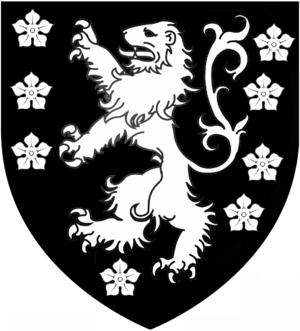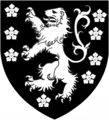Sir Gervase Clifton, 1st Baronet facts for kids
Sir Gervase Clifton, 1st Baronet (born 25 November 1587 – died 28 June 1666) was an important English politician. He was a member of the House of Commons, which is like the main law-making body in England. He was also a Knight of the Bath, which was a special honour given by the King. During the English Civil War, he strongly supported the King's side, known as the Royalists. He studied at St John's College, Cambridge, a famous university.
Contents
Sir Gervase Clifton's Political Life
Sir Gervase Clifton had a long and active career in politics.
Early Career and Royal Honours
In 1603, when King James I became king of England, Gervase Clifton was made a Knight of the Order of the Bath. This was a special award given to important people. In 1609, he became a Justice of the Peace for Nottinghamshire, which meant he helped keep law and order in the area.
In 1611, he was one of the first people to be given the new title of baronet. A baronet is a special title that can be passed down in a family, like a knight but with a hereditary rank.
Roles in Nottinghamshire
Sir Gervase was very involved in local politics in Nottinghamshire. In 1610, he was the High Sheriff of Nottinghamshire, a very important local official. From 1616 to 1647, he was the High Steward of East Retford, another key local position.
He was elected as a Member of Parliament (MP) for Nottinghamshire several times: in 1614, 1621, 1624, and 1625. An MP is a person chosen by the people to represent them in Parliament. He also served as the County Treasurer from 1625 to 1626, managing the county's money. From 1626 to 1642, he was a Deputy Lieutenant, helping the main official of the county.
In 1626, he became an MP for Nottingham. He was re-elected for Nottinghamshire in 1628. He stayed in Parliament until 1629, when King Charles I decided to rule without Parliament for eleven years.
English Civil War and Its Impact
In November 1640, Sir Gervase was elected an MP for East Retford in what was called the Long Parliament. When the English Civil War began, he chose to fight for King Charles I. He worked as a special helper for the King in places like Newark and Oxford. He also helped gather soldiers for the King in Lincolnshire and Nottinghamshire in 1642.
When King Charles asked his loyal MPs to meet in Oxford, Sir Gervase joined them. Because of this, he was no longer allowed to be an MP in the main Parliament in Westminster.
After the King's side lost the Civil War in 1646, Sir Gervase lost his political power. He was called a "delinquent" because he had supported the King against Parliament. He had to pay a very large fine of £7,625, which was a huge amount of money back then. His family's lands were also taken away for a time, but he managed to pay off about half the fine by 1650. He did not take part in politics again until the King was brought back to power in 1660.
Return to Politics
After the monarchy was restored in 1660, Sir Gervase Clifton regained his influence. He became a Justice of the Peace for Nottinghamshire again, and also High Steward of East Retford and Deputy Lieutenant. In 1661, he was re-elected as an MP for Nottinghamshire in the Cavalier Parliament. He held all these important positions until he passed away in 1666 at the age of 78.
Sir Gervase Clifton's Family Life
Sir Gervase Clifton was born in 1587, three months after his father, Sir George Clifton, died. The next year, when his grandfather also passed away, Gervase inherited the family estates in Nottinghamshire. His early care was looked after by his grandmother, Lady Anne Thorold. He later studied at St. John's College, Cambridge, and also at the Inner Temple, which was a place for legal training.
Sir Gervase Clifton was married seven times and had thirteen children.
His Marriages and Children
- He first married Lady Penelope Rich (died 1613). She was the daughter of Robert Rich, 1st Earl of Warwick. They had one son:
- Sir Gervase Clifton, 2nd Baronet (around 1612–1676)
- His second wife was Lady Frances Clifford (died 1627). She was the daughter of Francis Clifford, 4th Earl of Cumberland. They had six children:
- Margaret Clifton (died 1697/98)
- Frances Clifton
- Anne Clifton
- Lettice Clifton (died 1659)
- Elizabeth Clifton
- Clifford Clifton (1626–1670)
- He then married Mary Egioke (died 1630).
- His fourth wife was Isobel Meek (died 1637).
- He later married Anne South (died 1639).
- His sixth wife was Jane Eyre (died 1655). They had four children:
- Jane Clifton
- Charles Clifton
- Mary Clifton
- Robert Clifton (born 1641) – who later became Sir Gervase Clifton, 4th Baronet
- Lastly, he married Lady Alice Hastings on 17 December 1656 in London. She was the daughter of Henry Hastings, 5th Earl of Huntingdon.
Images for kids



